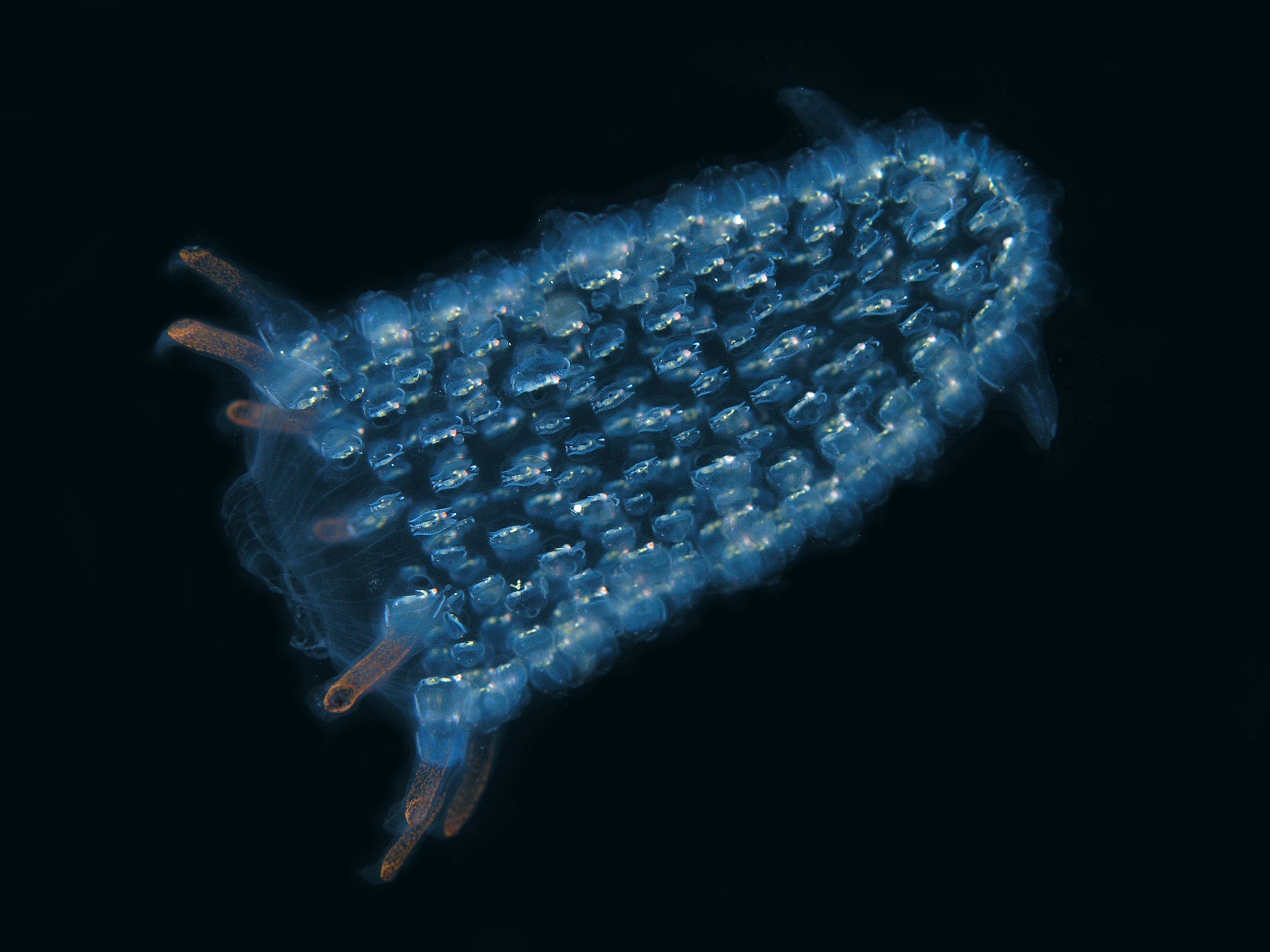- Pyrosome
image_caption = A young pyrosome colony found offAtauro Island ,East Timor
(length about 1 cm).
regnum =Animal ia
phylum =Chordata
subphylum =Urochordata
classis =Thaliacea
ordo =Pyrosomida
familia =Pyrosomidae
genus = "Pyrosoma"Pyrosomes, or pyrosoma, are free-floating colonial
tunicates that live usually in the upper layers of the open ocean in warm seas, although some may be found to great depth. Pyrosomes are cylindrical or conical shaped colonies made up of hundreds to thousands of individuals, known as zooids. Colonies range in size from less than one centimeter to several meters in length.Each zooid is only a few millimeters in size, but is embedded in a common gelatinous tunic that joins all of the individuals. Each zooid opens both to the inside and outside of the "tube", drawing in ocean water from the outside to its internal filtering mesh called the branchial basket, extracting the microscopic plant cells on which it feeds, and then expelling the filtered water to the inside of the cylinder of the colony. The colony is bumpy on the outside, each bump representing a single zooid, but nearly smooth, though perforated with holes for each zooid, on the inside.
Pyrosomes are
plankton ic, which means that their movements are largely controlled by currents, tides and waves in the oceans. On a smaller scale, however, each colony can move itself slowly by the process of jet propulsion, created by the coordinated beating ofcilia in the branchial baskets of all the zooids, which also create feeding currents.Pyrosomes are brightly bioluminescent, flashing a pale blue-green light that can be seen for many tens of meters. The name "Pyrosoma" comes from the Greek ("pyro" = "fire", "soma" = "body"). Pyrosomes are closely related to
salp s, and are sometimes called "fire salps." Sailors on the ocean are occasionally treated to calms seas containing many pyrosomes, all bioluminescencing on a dark night.Bioluminescence
Although many planktonic organisms are bioluminescent, pyrosome bioluminescence is unusual in its brilliance and sustained light emission [cite journal|last=Bowlby|first=M.R.|coauthors=E.A. Widder and J.F. Case|date=1990|title=Patterns of stimulated bioluminescence in two pyrosomes (Tunicata: Pyrosomatidae)|journal=Biological Bulletin|volume=179|pages=340-350] , and evoked the following comment when seen by scientist T.H. Huxley at sea:
“I have just watched the moon set in all her glory, and looked at those lesser moons, the beautiful Pyrosoma, shining like white-hot cylinders in the water” (T.H. Huxley, 1849). [cite book|last=Huxley|first=J.|title=T.H. Huxley's Diary of the Voyage of H.M.S. Rattlesnake|publisher=Doubleday|location=Garden City, New York|date=1936]
Pyrosomes often exhibit waves of light passing back and forth through the colony, as each individual zooid detects light and then emits light in response. Each zooid contains a pair of light organs located near the outside surface of the tunic, which are packed with luminescent organelles that may be intracellular bioluminescent bacteria. [cite journal|last=Mackie|first=G.O.|coauthors=Bone, Q.|date=1978|title=Luminescence and associated effector activity in "Pyrosoma" (Tunicata: Pyrosomida)|journal=Proc. Royal Soc. London Series B |volume=202|pages=483-495] The waves of bioluminescence that move within a colony are apparently not propagated through neurons, but by a photic process. [cite journal|last=Mackie|first=G.O.|coauthors=Bone, Q.|date=1978|title=Luminescence and associated effector activity in "Pyrosoma" (Tunicata: Pyrosomida)|journal=Proc. Royal Soc. London Series B |volume=202|pages=483-495] Flashing zooids not only stimulate other zooids within the colony to bioluminesce, but nearby colonies will also display bioluminescence in response. Colonies bioluminesce in response to mechanical stimulation (touch), as well as to light. [cite journal|last=Bowlby|first=M.R.|coauthors=E.A. Widder and J.F. Case|date=1990|title=Patterns of stimulated bioluminescence in two pyrosomes (Tunicata: Pyrosomatidae)|journal=Biological Bulletin|volume=179|pages=340-350]
Bibliography
Bone, Q. editor (1998) The Biology of Pelagic Tunicates. Oxford University Press, Oxford. 340 pp.
References
External links
* [http://www.mar-eco.no/mareco_news/2004/the_pyrosome_story Huge pyrosome captured in the North Atlantic - story and images]
* [http://www.divebums.com/FishID/Pages/pyrosoma_atlanticum.html Some nice images taken by divers off southern California]
* [http://www.lifesci.ucsb.edu/~biolum/ The Bioluminescence Web Page]
Wikimedia Foundation. 2010.

